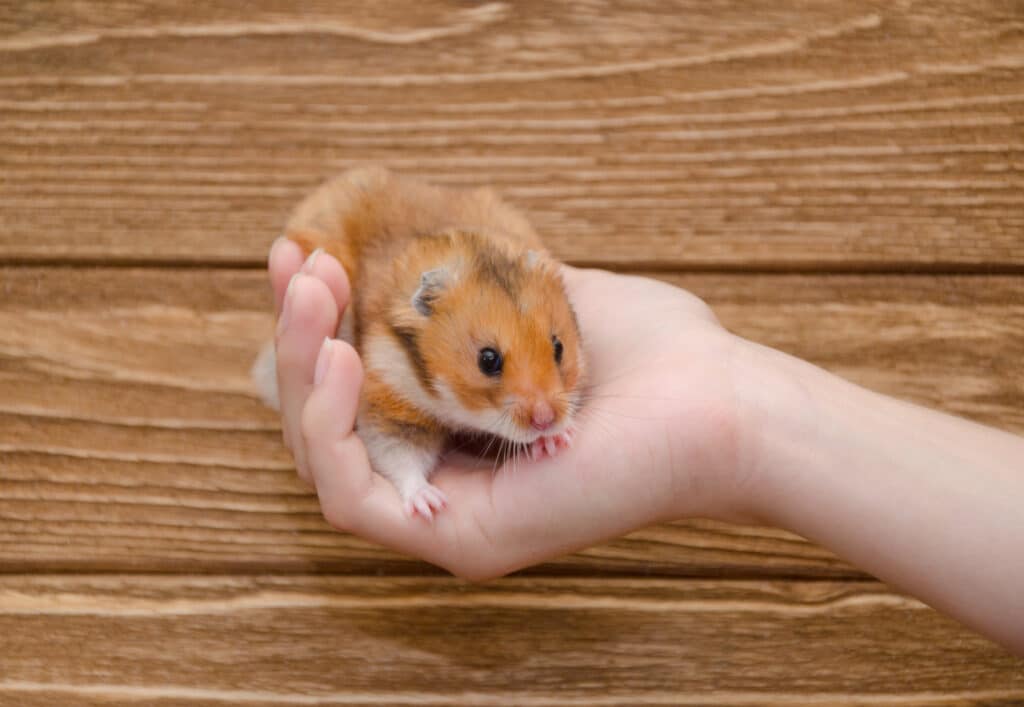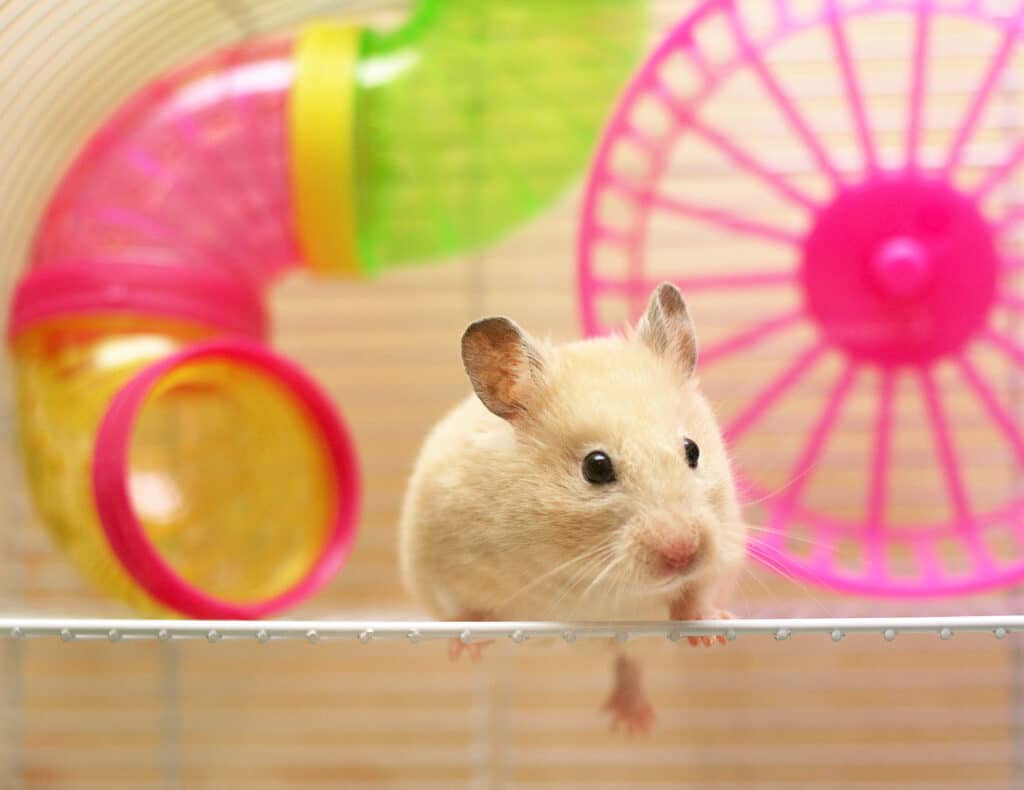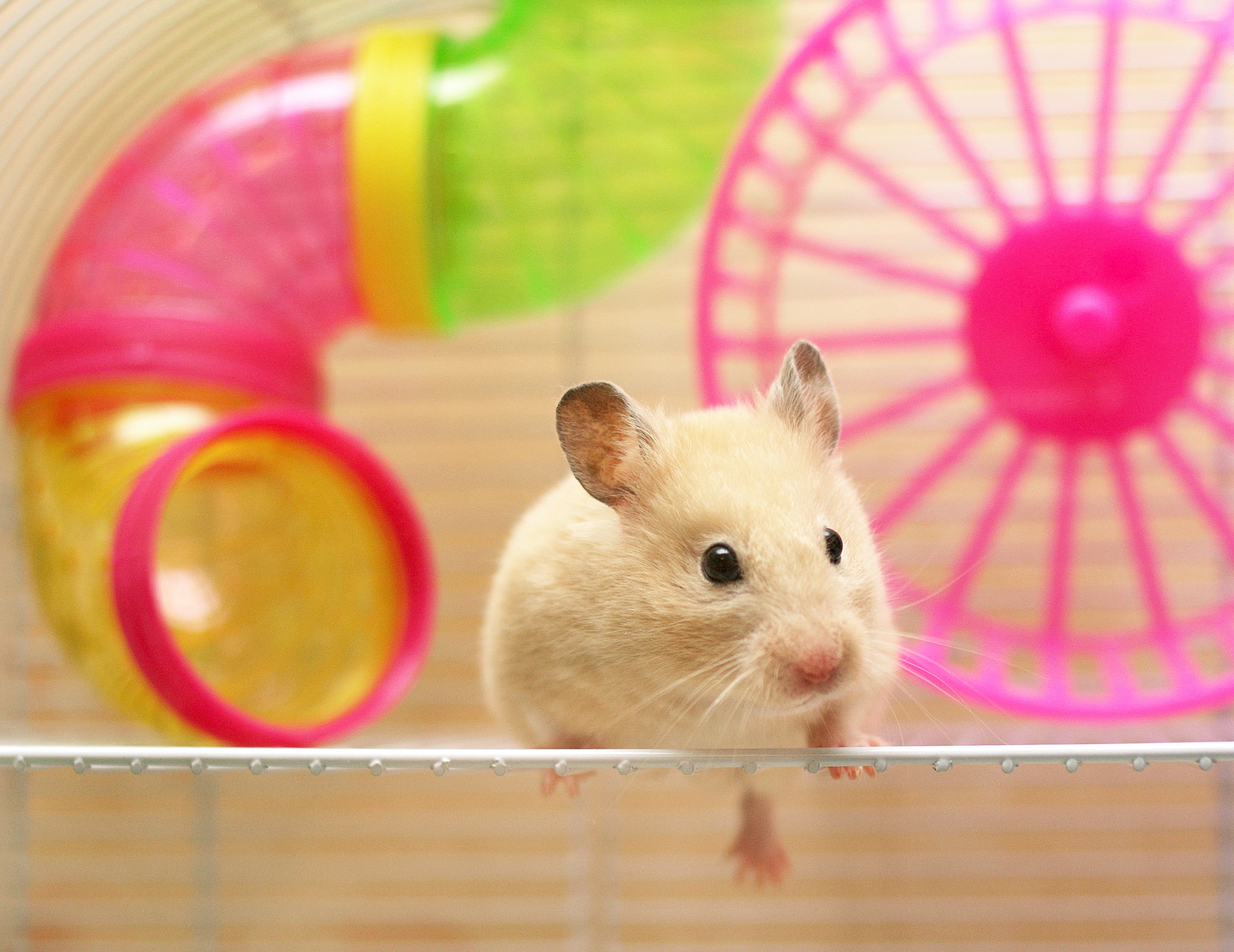Looking after a hamster is a great responsibility. As a hamster owner, you have to make sure that you give your hamster the right hamster food and recognize immediately when your hamster is sick. But it might be challenging since your hamster cannot tell you if he is feeling sick or if any part of his body is paining. However, a hamster’s pee, poop, and behavior can tell you a lot about his health.
In this blog post, you will find out everything you need to know about hamster pee and how to use it to find out if your hamster is sick.
What color is hamster pee?
A hamster’s pee is normally milky white in color and thicker than a human’s urine.
Why is my hamster’s pee white?
A hamster’s kidneys filter out a lot of calcium from his body (Source: Just Hamsters). So, a hamster’s urine contains a lot of calcium. Hence, it is milky white in color. When a hamster’s urine travels through the bedding and reaches the bottom of the cage, it can harden and become difficult to remove because calcium hardens with time.
If your hamster is healthy, his urine will be milky white in color. If it is any color other than thick, milky white, it might be an indication of an underlying problem. Read through this blog post to find out the reason behind every hamster pee color.
Why is my hamster’s pee transparent?
Just like a human’s urine, a hamster’s urine, too, can become transparent if he drinks too much water.
A hamster might drink too much water due to excessive thirst. Excessive thirst may be caused by one of the following factors (Source: Petsvills):
1. Dehydration
2. A room that is too hot for a hamster
3. Increased activity
4. Diet (A diet rich in salt or a diet that is made primarily of dry foods)
5. Digestive issues
6. Urinary tract infection
7. Diabetes
8. Kidney disease
9. Pregnancy
10. Boredom
So, find out the reason why your hamster drinks too much water and take action accordingly. If you think your hamster is suffering from any medical condition like diabetes, kidney disease, etc., take him to a veterinary doctor immediately.
Why is my hamster’s pee red?
Your hamster’s pee might be red due to the following reasons:
Food
If your hamster’s pee is red in color, it doesn’t necessarily mean that he is sick. It might have also been caused by the following food items:
Beetroot
Beetroots contain a class of chemical compounds called Betalain (Source: Canadian Academy of Sports Nutrition).
Betalain is also used as a coloring agent in the food industry. So, if your hamster’s mix contains colored biscuits, they might also contain betalain.
Your hamster’s body doesn’t have any use for betalain. So it is filtered out by the kidneys into the urine. This condition is called Beeturia and occurs in humans, too (Source: Beetit). However, it is not harmful.
Carrot
Carrots are a rich source of chemical compounds like lycopene, carotenoids, and anthocyanins, which act as antioxidants. But if your hamster’s body is not able to utilize these chemical compounds effectively, they might be eliminated through his urine, thus resulting in a change in urine color.
Orange carrots, which are rich in carotenoids, can change urine color to orange. Red and purple carrots, which are rich in lycopene, can change urine’s color to pink or red (Source: Nature Word). Dark purple and black carrots, which are rich in anthocyanins, can make urine dark in color.
Blackberries
Just like dark purple carrots, blackberries are also a rich source of anthocyanins. So, they can also make your hamster’s urine turn dark in color.
If the change in urine color was caused by food, change your hamster’s diet and make him drink water. If he hates drinking water directly, provide watery fruits or a dilute solution of glucose in water.
Sickness
Besides food, urogenital diseases can also make your hamster’s urine appear red or cause blood to appear in urine. The following diseases might be the reason behind the change in your hamster’s urine color.

Urinary Tract Infection (UTI)
Unlike humans, hamsters are butt-naked all the time. Moreover, they are very small. So, their bodies are very close to the ground if not touching it. Therefore, harmful bacteria and other pathogens can easily enter their bodies through the urethra and infect the bladder. Hence, UTI is very common among small mammals. It can affect hamsters of both genders, even though it is more common among female hamsters.
UTI is a very painful condition for hamsters. The bodies of hamsters will try to flush out the bacteria by consuming more liquids (Source: Hamster Society Singapore). So, keep enough water for him to drink.
Some symptoms of UTI are:
- Thick urine
- Pain and difficulty in urinating (Your hamster might squeak while peeing)
- Blood traces in urine (If you are not sure the urine is just red or if there is blood in urine, let it dry. If the urine contains blood, it will become brown upon drying.)
- Loss of appetite and/or interest in eating
- Poorly groomed coat
- Lethargy
- Excessive thirst
Causes of UTI:
- Unhygienic living conditions – The main cause of UTI in hamsters is unhygienic living conditions. A hamster’s cage must be clean. If not, bacteria and fungus can start growing in the bedding, which can then travel through your hamster’s urethra and infect his bladder.
- Stress – Hamsters are tiny, timid creatures. They can get frightened and stressed out easily. Stress can cause UTI and other deadlier conditions like Wet Tail in hamsters. So, you should avoid things that can stress your hamster, like loud sounds, suddenly moving his cage, or changing his daily routine all of a sudden.
- Urinary blockage – Any blockage of the urinary tract, leading to difficulty in urinating, can also cause UTI. So, if your hamster is experiencing difficulty or pain while urinating, take him to a vet immediately.
- Obesity and laziness – Just like in humans, in hamsters, too, obesity and laziness can cause multiple health problems, including UTI (Source: Tiny Pet Tales).
How to treat UTI in hamsters?
- Keep fresh water every day – As explained above, if your hamster has UTI, his body will try to ingest as much liquid as possible to flush out the infection. So, you should keep enough fresh water for him every day.
- Give yogurt or unsweetened cranberry juice – These food items can help flush out some harmful bacteria from your hamster’s body and provide some comfort for the troubled animal (Source: Cuteness).
- Take your pet to a vet – UTIs rarely goes away on their own. So, if you find out that your hamster has UTI, you should immediately take him to a vet. Steps 1 and 2 are only temporary measures that help until you visit the vet. They should not be used as a replacement for a visit to a vet.
- Follow the treatment plan of the vet – This will include administering the dose of antibiotics the vet prescribed for your hamster for the full course and, maybe, a change in your hamster’s diet. Do not stop administering the medicine to your hamster before the full course is over, even if he looks healthy. If required, plan a visit to the vet after the UTI has been cured.
How to prevent UTI in hamsters?
- Keep your hamster’s cage clean. Remove uneaten food items and spot-clean the place where your hamster urinates every day. If not, they can rot and lead to build-up of fungus and bacteria. Moreover, once a week or so, you should also change most of your hamster’s bedding and sanitize his cage, food bowl, wheel, and toys. Keep a sand bath in the cage for your hamster to clean himself.
- Avoid making loud sounds and sudden movements. Don’t change your hamster’s schedule abruptly.
- Avoid adding too many sugary and fattening items to your hamster’s diet. If you are wondering what to give your hamster and what not to give your hamster, these blog posts can help: What can hamsters eat? What can hamsters not eat?
Why is my hamster’s pee pink?
Your hamster’s pee might be pink due to the following reasons:
Food
Just like red pee, your hamster can have pink pee after eating some fruits like pomegranates, strawberries, etc.
Blood in hamster’s urine
Another reason why your hamster’s urine might be pink is if it contains blood. This condition is called Hematuria and is very dangerous. If you aren’t sure if pink pee is the result of blood in urine, let it dry. If the pink color turns brown upon drying, it indicates the presence of blood.
Hematuria can be caused due to bladder stones, bladder inflammation, kidney inflammation, tumors and cancers, and internal or external injuries (Source: Davies Veterinary Specialists, UK). Let’s look at some of these causes in detail below:
Tumors and Cancers
Tumors can lead to swelling, resulting in the discharge of blood and other fluids from the urinary tract of hamsters. It occurs mostly in older hamsters. Female hamsters can get tumors when they give birth. This leads to consistent bleeding.
Besides tumors, pyometra can also lead to discharge of fluid from the vulva of female hamsters.
Bladder stones
If your hamster has bladder stones, he will show some of the below symptoms in addition to blood in the urine (Source: Mayne Veterinary Clinic):
- Frequent urination
- Increased water consumption
- Straining while urinating
- Poor appetite
- UTI
An experienced vet will be able to remove the stones and prescribe antibiotic treatments so that your hamster can get better. Two such incidences of the removal of bladder stones can be found in these websites: 1 and 2.
Most often, the cause of bladder stones is water or food that contains too many minerals. Dry food could also be a predisposing factor. So, once your hamster is cured, you should alter his diet to avoid food items that contain too much salts like oxalates and carbonates.
Internal injuries
Hamsters are playful creatures that keep running around all the time. But they cannot see very well. The best a hamster can see is probably 3 inches past his nose.
So, if you have any elevated structures in your hamster’s cage, he will not be able to tell how tall it is if it is more than 3 inches tall. So, he might jump from these structures and end up injuring his internal organs like kidneys.
Such internal injuries can cause internal bleeding that appears as blood in the urine. Thus, internal injuries can also make his urine appear pink.
External injuries
Since hamsters are tiny creatures, their reproductive organs are very close to the ground. So, if there are any sharp objects on the bedding, they might injure your hamster’s reproductive organs, causing blood to appear in the urine.
But unlike internal injuries, external injuries will be visible if you observe your hamster carefully. So, if your hamster’s pee is pink, check his/her underside as well to see if there is any swelling or bleeding. Observe your hamster’s behavior to find out if your hamster scratches his genitals often.
UTI in hamsters
Just like red pee, pink pee, too, can be caused by urinary tract infections.
If your hamster has pink pee, it means that the situation is serious. If your hamster also has difficulty in walking/moving, shows reduced activity, is reluctant to eat, and/or if any discharge comes out from the genitals, you should consult a vet as soon as possible.
Why is my hamster’s pee orange?
If your hamster is dehydrated, his pee will be orange or orange-brown. You will notice some other symptoms mentioned below as well (Source: Hamsters Info):
- Weight loss and loss of fur
- Lethargy or becoming lazy – Dehydration can deprive your hamster of energy. So, your hamster might become lazy or lethargic.
- Smelly urine
- Tight skin – Hold your hamster near the back of his neck. If the skin there is tight, it is a pretty good indication that he is severely dehydrated.
If your hamster is dehydrated, keep enough fresh water for him to drink every day. If he doesn’t drink much water from the water bottle, try feeding him vegetables or fruits rich in water, like cucumber. In case you have multiple hamsters, keep several water bottles across the cage, so that the dominant hamster doesn’t prevent the other hamsters from drinking water from his water bottle.
Why is my hamster’s pee brown?
Your hamster’s pee could be brown due to 2 reasons:
1. Blood in urine
Just like pink pee, brown pee, too, could be due to blood in the urine.
2. Liver problems
Bilirubin is an orange-yellow compound that is released when the bodies of vertebrates break down old or damaged red blood cells. The liver takes this chemical compound from the blood and converts it into bile to be passed down through poop (Source: WebMD).
When your liver is inflamed or damaged due to diseases like hepatitis, it won’t be able to clean the blood properly. This can lead to an increase in bilirubin in the blood and urine, making the urine turn brown (Source: WebMD). This can happen to hamsters as well. So, take your hamster to a vet for a checkup if his urine becomes brown in color.
Why is my hamster’s pee yellow?
It is normal for a hamster’s pee to be yellow. Yellow pee doesn’t indicate any underlying condition.
Why is my hamster’s pee cloudy white?
If your hamster’s pee is cloudy, it could be due to the inflammation of his kidneys. This condition is called nephritis. If your hamster has nephritis, he will also show some of the symptoms mentioned below:
- High body temperature
- Dry coat
- Depressed/dull appearance
- Severe thirst
- Increased urination
Nephritis can be caused by viral or bacterial infection, high blood pressure in the kidneys, and immune system disorders (Source: PetMD). So, take your hamster to a veterinary doctor without delay. A vet will prescribe antibiotics if your hamster’s nephritis is caused by kidney infections. He may also administer fluids.
If your hamster’s urine is white and excessively thick, he might be suffering from hypercalciuria. Hypercalciuria is a condition where there is an abnormally high amount of calcium salts in the urine (Source: Wikipedia).
If your hamster’s urine contains a high amount of calcium salts, then change his diet. Replace vegetables, nuts, and seeds that are rich in calcium with those that contain fewer amounts of calcium. Get pellets that contain less calcium.
If your hamster’s urine changes color suddenly and you become concerned about it, take him to a vet asap.
Summary
The hamster pee chart below summarizes the most important points in this blog post.
Hamster Pee Chart
| Color of pee | Inference / Cause | |
| 1 | Thick, milky white | Hamster is healthy |
| 2 | Transparent | Hamster drinks too much water |
| 3 | Red | UTI, food (Beetroot, carrot, etc.) |
| 4 | Pink | Blood in urine (Caused by UTI, tumors, bladder stones, internal or external injuries), food (Strawberries, pomegranates, etc.) |
| 5 | Orange | Dehydration |
| 6 | Brown | Blood in urine, liver problems |
| 7 | Yellow | Hamster is healthy |
| 8 | Cloudy white | Inflammation of kidneys, too much calcium in urine |
Don’t forget to read our blog post on hamster poop.



